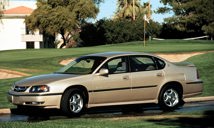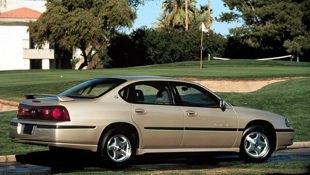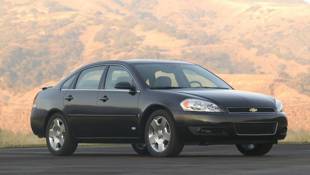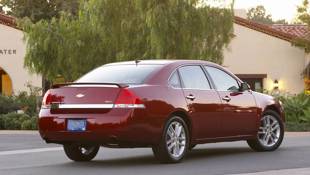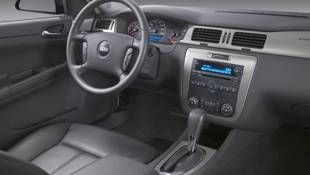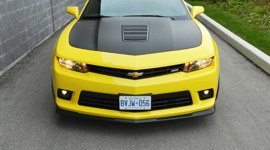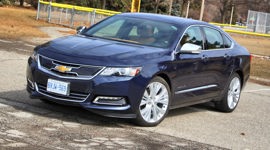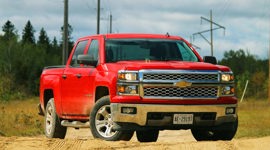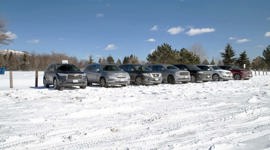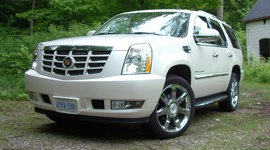Update by Justin Pritchard; original article by Chris Chase
Update: Chevrolet Impala, 2006–2013
Here’s a closer look at some common problems and issues identified by the owners community, with some more detailed information that’s emerged in recent years.
A popular used-car buy when affordability, size, space, comfort and power are priorities, the last-generation Chevrolet Impala was available for model years 2006 to 2013 inclusive, before being replaced by the current-generation model.
Highly reasonable pricing, standard V6 power, solid reliability and low running costs continue to add appeal to the last-generation Chevrolet Impala as a used car buy. Top line models got heated leather, Bose audio, automatic climate control, Bluetooth and more.
Look for four doors and front-wheel drive on all models, with an automatic transmission as standard. Six or eight-cylinder engines were available, with up to 303 horsepower. A 3.5L V6 generated 211 horsepower, and a 3.9L V6 generated 233.
Here’s a closer look at some common problems and issues identified by the owners community, with some more detailed information that’s emerged in recent years. We’ll also advise some checks that should be considered mandatory ahead of purchasing a used Impala from this generation.
Some owners have reported trouble with the transmission ‘slipping’, perhaps especially when changing from reverse to drive. Ensure that’s not the case with the transmission in the Impala you’re considering. If you detect any signs of slippage or hard shifting, the likely culprit is computer-related and not mechanical in nature, though you’ll want to have a mechanic investigate to be sure. Computer-related problems can typically be fixed on the cheap with new programming and updated software. Mechanical problems with the transmission can be pricier and more involved to fix, especially if they relate to a bad pump or solenoid within the transmission itself. Translation? Any transmission-related funny-business you detect on a test drive warrants further investigation to compare potential repair costs against the value of the model being considered.
Note that having a computer ‘scan’ of the used Impala’s computer systems is highly advised, as it may reveal potential issues with the transmission or other components. A GM technician can complete a full electronic systems scan in a matter of minutes.
The owner’s community has also determined that intermittent assist from the power steering system may be the result of a misaligned harmonic balancer, which is basically a pulley that also drives the power steering pump via a belt. A misaligned harmonic balancer can cause damage to the belt, power steering pump pulley, and negatively affect steering system performance. If issues are detected, this is a relatively easy fix.
On models with the 3.5L engine, be sure to check for oil and coolant leaks, particularly caused by leaky gaskets. A check of numerous posts on owner’s forums shows that this engine may leak from its oil pan gasket, crank seals, crossover coolant pipes and oil filter adapter.
Newer models may feature OnStar navigation capability, even if the vehicle itself isn’t equipped with a navigation system. Confirm this handy system works properly by ensuring there’s an active OnStar subscription and pressing the blue OnStar button. Ask the advisor if they’re able to communicate with your potential used Impala candidate, and if they can ‘see’ it via GPS. If that’s not the case, the system’s GPS module may be in need of replacement. Confirm that the Bluetooth phone system, if equipped, is working properly too, by pairing your phone and making a call.
Review by Chris Chase
Since 2000, Chevrolet’s Impala has been one of General Motors’ best sellers in the family sedan class. Its simple styling, spacious interior and strong V6 engines have made it popular with drivers looking for an economical, affordable and comfortable way to get around.
In early cars, engine choices included 3.4-litre and 3.8-litre V6 engines. An SS trim added in 2004 got a supercharged version of the 3.8-litre motor.
The updated 2006 model got new engines: a 3.5-litre V6 replaced the 3.4-litre, and a 3.9-litre V6 was added in 2007. The SS model used GM's small block 5.3-litre V8. All Impalas used a four-speed automatic transmission.
For 2010, the SS and its V8 engine were discontinued, and in 2012, the 3.5 L and 3.9 L engines were displaced by GM's 3.6 L V6. As well, the four-speed automatic paired with those old engines was dropped in favour of a standard six-speed.
GM's V6 engines are known for decent fuel consumption, and the Impala was no exception here. In 2002, the 3.4-litre model earned Natural Resources Canada ratings of 11.0/6.7 L/100 km, (city/highway) while the 3.8-litre model was rated at 12.6/7.9 L/100 km. The supercharged SS model was rated 13.4/8.2 L/100 km.
In 2007, ratings for 3.5- and 3.9-litre models were very similar, at 11.5/7.2 and 11.9/7.5 L/100 km, respectively. The small block powered SS was rated at 12.9/8.1 L/100 km.
Fuel consumption for the 3.6 L/six-speed combo was rated 11.7/6.7 L/100 km.
Of all of the engines offered in the Impala, my favourite is the 3.8-litre, for its well-documented durability. The older 3.4-litre V6 is one of the engines known for troublesome gasket leaks. The newer 3.5- and 3.9-litre engines used from 2006 on are based on the 3.4-litre's design, but to my knowledge, GM addressed the gasket issues in these motors, so they should prove durable in the long haul.
Check this site for more info on common problems with the Impala's four-speed automatic. (Click on the “4T65E Info & Problems” tab at the time of the page for a list of known problems.) This page details a couple causes of outright four-speed failures, which are not uncommon.
An Impala transmission that gets stuck in park is likely caused by the brake-shift interlock solenoid, which can short out.
The 2012 model's six-speed transmission is the 6T70 model that GM co-developed with Ford. There's no evidence of problems (yet) in the Impala, but this is the same gearbox that has proven problematic in the 2010-2012 Ford Fusion and 2009-2012 Escape.
An external coolant leak from a 3.5 or 3.9 L engines could be related to this technical service bulletin, issued to address leaking cylinder head gaskets.
A check engine light triggered by the evaporative emissions system could be caused by a bad vent valve, located at fuel filler neck, behind the rear quarter panel. According to this thread and this post in particular, it's a pretty easy and inexpensive fix.
Problems with the instruments (speedometer, tachometer, etc.) are common in the Impala; see this thread for a few suggestions.
Other notable trouble spots involve brake rotors prone to warping, premature brake pad wear and poor-quality body hardware and interior components, all of which are typical of GM products from this era.
Consumer Reports' used vehicle rating depends on model year; its overall opinion of this car's reliability varies from average to much worse than average.
The Impala’s crash safety record is excellent – even without the optional side airbags, this big sedan has earned five stars from the U.S. National Highway Traffic Safety Administration (NHTSA) for driver and front passenger protection in frontal impacts and four stars for front and rear seat occupants in side impacts. Likewise, the Impala earned a “good” rating from the Insurance Institute for Highway Safety (IIHS) in that organization’s frontal offset impact test.
The redesigned 2006-and-newer Impala earned an "acceptable" rating from the IIHS in frontal offset testing, until structural enhancements for cars built after December 2010 that helped the car earn a “good” rating from then on. All Impalas got a "good" rating in side impact tests. From the NHTSA, the newer car earned five stars all around, except for a four-star rating in rear side side impact protection.
Despite its standard V6 power, the Impala comes in far less expensive than most similarly-equipped import family sedans - even those with four-cylinder engines. A 2010 Impala is worth several thousand less than an Accord or Camry; the margin is much narrower between the Chev and Hyundai's Sonata, but that Korean sedan is still worth more.
At face value, a used Impala is a fantastic deal for a big, comfortable sedan, but its questionable build quality makes it a car best approached with caution. If you're willing to take that chance, look for a car that comes with detailed service records and evidence that it was very well maintained. Newer models with some factory warranty remaining would be the best cars to consider.
|
Pricing
Black Book Pricing (avg. retail) May, 2012:
Online resources
Recalls
|
